Related Research Articles

In classical soil science, humus is the dark organic matter in soil that is formed by the decomposition of plant and animal matter. It is a kind of soil organic matter. It is rich in nutrients and retains moisture in the soil. Humus is the Latin word for "earth" or "ground".
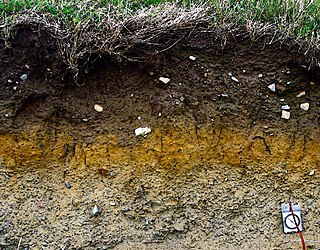
Soil, also commonly referred to as earth or dirt, is a mixture of organic matter, minerals, gases, liquids, and organisms that together support the life of plants and soil organisms. Some scientific definitions distinguish dirt from soil by restricting the former term specifically to displaced soil.
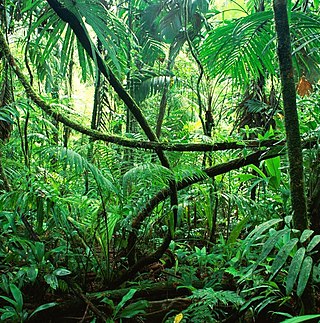
Rainforests are forests characterized by a closed and continuous tree canopy, moisture-dependent vegetation, the presence of epiphytes and lianas and the absence of wildfire. Rainforests can be generally classified as tropical rainforests or temperate rainforests, but other types have been described.
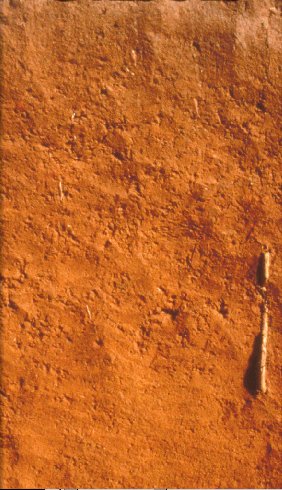
Oxisols are a soil order in USDA soil taxonomy, best known for their occurrence in tropical rain forest within 25 degrees north and south of the Equator. In the World Reference Base for Soil Resources (WRB), they belong mainly to the ferralsols, but some are plinthosols or nitisols. Some oxisols have been previously classified as laterite soils.
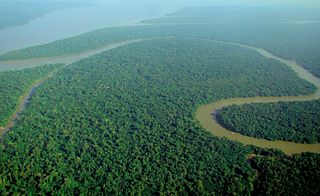
Tropical rainforests are dense and warm rainforests that occur in tropical rainforest climate where there is no dry season – all months have an average precipitation of at least 60 mm. True rainforests are typically found between 10 degrees north and south of the equator ; they are a subset of the tropical forest biome that occurs roughly within the 28-degree latitudes. Tropical rainforests are a type of tropical moist broadleaf forest, that includes the more extensive seasonal tropical forests.
USDA soil taxonomy (ST) developed by the United States Department of Agriculture and the National Cooperative Soil Survey provides an elaborate classification of soil types according to several parameters and in several levels: Order, Suborder, Great Group, Subgroup, Family, and Series. The classification was originally developed by Guy Donald Smith, former director of the U.S. Department of Agriculture's soil survey investigations.
The pedosphere is the outermost layer of the Earth that is composed of soil and subject to soil formation processes. It exists at the interface of the lithosphere, atmosphere, hydrosphere and biosphere. The pedosphere is the skin of the Earth and only develops when there is a dynamic interaction between the atmosphere, biosphere, lithosphere and the hydrosphere. The pedosphere is the foundation of terrestrial life on Earth.
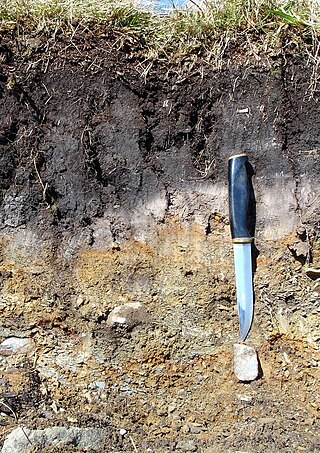
In soil science, podzols are the typical soils of coniferous or boreal forests and also the typical soils of eucalypt forests and heathlands in southern Australia. In Western Europe, podzols develop on heathland, which is often a construct of human interference through grazing and burning. In some British moorlands with podzolic soils, cambisols are preserved under Bronze Age barrows.

Terra preta is a type of very dark, fertile anthropogenic soil (anthrosol) found in the Amazon Basin. It is also known as "Amazonian dark earth" or "Indian black earth". In Portuguese its full name is terra preta do índio or terra preta de índio. Terra mulata is lighter or brownish in color.

The unofficial geographic term Northern Australia includes those parts of Queensland and Western Australia north of latitude 26° and all of the Northern Territory. Those local government areas of Western Australia and Queensland that lie partially in the north are included.

Worldwide more human beings gain their livelihood from agriculture than any other endeavor; the majority are self-employed subsistence farmers living in the tropics. While growing food for local consumption is the core of tropical agriculture, cash crops are also included in the definition.

Brown earth is a type of soil. Brown earths are mostly located between 35° and 55° north of the Equator. The largest expanses cover western and central Europe, large areas of western and trans-Uralian Russia, the east coast of America and eastern Asia. Here, areas of brown earth soil types are found particularly in Japan, Korea, China, eastern Australia and New Zealand. Brown earths cover 45% of the land in England and Wales. They are common in lowland areas on permeable parent material. The most common vegetation types are deciduous woodland and grassland. Due to the reasonable natural fertility of brown earths, large tracts of deciduous woodland have been cut down and the land is now used for farming. They are normally located in regions with a humid temperate climate. Rainfall totals are moderate, usually below 76 cm per year, and temperatures range from 4 °C in the winter to 18 °C in the summer. They are well-drained fertile soils with a pH of between 5.0 and 6.5.
Podsolisation is an extreme form of leaching which causes the eluviation of iron and aluminium sesquioxides.

Red soil is a type of soil that typically develops in warm, temperate, and humid climates and comprise approximately 13% of Earth's soils. It contains thin organic and organic-mineral layers of highly leached soil resting on a red layer of alluvium. Red soils contain large amounts of clay and are generally derived from the weathering of ancient crystalline and metamorphic rock. They are named after their rich red color, which can vary from reddish brown to reddish yellow as a result of their high iron content. Red soil can be good or poor growing soil depending on how it is managed. It is usually low in nutrients and humus and can be difficult to cultivate due to its low water holding capacity; however, the fertility of these soils can be optimized with liming and other farming techniques.
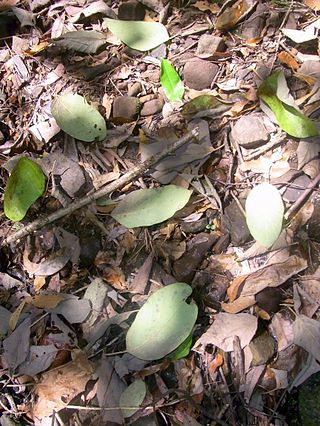
Plant litter is dead plant material that have fallen to the ground. This detritus or dead organic material and its constituent nutrients are added to the top layer of soil, commonly known as the litter layer or O horizon. Litter is an important factor in ecosystem dynamics, as it is indicative of ecological productivity and may be useful in predicting regional nutrient cycling and soil fertility.

Laterite is a soil type rich in iron and aluminium and is commonly considered to have formed in hot and wet tropical areas. Nearly all laterites are of rusty-red coloration, because of high iron oxide content. They develop by intensive and prolonged weathering of the underlying parent rock, usually when there are conditions of high temperatures and heavy rainfall with alternate wet and dry periods. The process of formation is called laterization. Tropical weathering is a prolonged process of chemical weathering which produces a wide variety in the thickness, grade, chemistry and ore mineralogy of the resulting soils. The majority of the land area containing laterites is between the tropics of Cancer and Capricorn.

Nitisol, in the World Reference Base for Soil Resources (WRB), is a deep, red, well-drained soil with a clay content of at least 30% and a polyhedral structure or a blocky structure, breaking into a polyhedral or a flat-edged structure. The soil aggregates show pressure faces. Nitisols correlate with the kandic alfisols, ultisols and inceptisols of the USDA soil taxonomy.

There are seven soil deposits in India. They are alluvial soil, black soil, red soil, laterite soil, or arid soil, and forest and mountainous soil, marsh soil. These soils are formed by various geographical factors. They also have varied chemical properties. Sundarbans mangrove swamps are rich in marsh soil.
The soil matrix is the solid phase of soils, and comprise the solid particles that make up soils. Soil particles can be classified by their chemical composition (mineralogy) as well as their size. The particle size distribution of a soil, its texture, determines many of the properties of that soil, in particular hydraulic conductivity and water potential, but the mineralogy of those particles can strongly modify those properties. The mineralogy of the finest soil particles, clay, is especially important.
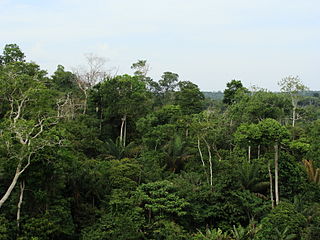
The Tropical Wet Forests are a Level I ecoregion of North America designated by the Commission for Environmental Cooperation (CEC) in its North American Environmental Atlas. As the CEC consists only of Mexico, the United States, and Canada, the defined ecoregion does not extend outside these countries to Central America nor the Caribbean.
References
- ↑ Delvaux, B.; Brahy, V. "Mineral Soils conditioned by a Wet (Sub)Tropical Climate". FAO. Retrieved 14 June 2014.
- ↑ Sanchez, P.A.; Logan, T.J. (1992). "Myths and science about the chemistry and fertility of soils of the tropics" (PDF). In Lal, R; Sanchez, P. A. (eds.). Myths and Science of Soils of the Tropics. Madison, Wisconsin: Soil Science Society of America. p. 36. Retrieved 14 June 2014.
- Various (2009). GCSE Geography AQA A Specification: The Revision Guide. CGP.
- Uehara, Gore; Gillman, Gavin (1981), Mineralogy Chemistry and Physics of Tropical Soils With Variable Charge Colloids, Westview Tropical Agriculture Series